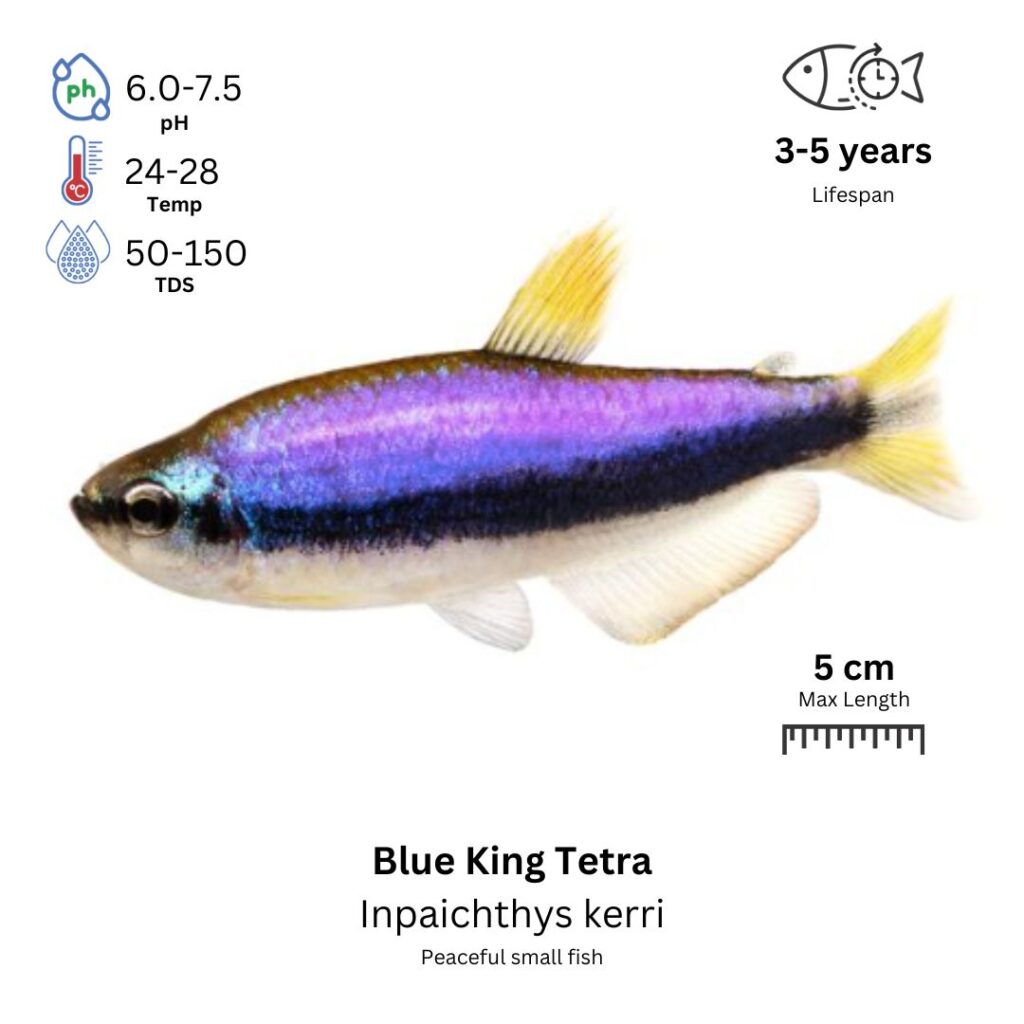Blue King Tetra
Tetraodon biocellatus

Description
The Blue King Tetra is a stunning freshwater fish known for its vibrant blue coloration and active, peaceful nature. Its body has an iridescent blue sheen that shimmers under the light, giving it a regal appearance. The male Blue King Tetra typically exhibits brighter, more vivid blue coloration compared to females. These fish have a streamlined body with a slightly elongated shape, and they possess a small, elegant dorsal fin. They are peaceful, schooling fish that enjoy swimming in the middle to upper regions of the tank. Their vivid coloration, especially in groups, adds a beautiful contrast to planted tanks, making them a popular choice among aquarists.
Habitat Origin
Native to the Rio Xingu in Brazil, South America, particularly in areas with clear, slow-moving waters, such as small tributaries and streams with plenty of vegetation and submerged wood.
Aquarium
Ideal Number in Aquarium: At least 6 individuals, as they are schooling fish and feel more secure in groups.
Favorite Food

Blue King Tetras are omnivores and will accept a variety of foods. They can be fed high-quality flake food, micro pellets, and live or frozen foods such as brine shrimp, daphnia, and bloodworms. They will also appreciate plant matter like algae and small plant-based foods, adding variety to their diet.
Behavior:
The Blue King Tetra is an active and peaceful fish that thrives in groups. They are non-aggressive and do well in community aquariums with other peaceful species. These fish are social creatures and feel most comfortable when kept in schools, where they exhibit their natural schooling behavior. They are constantly moving through the middle and upper sections of the tank, and their brilliant blue color becomes most striking when they are in a group. They are not territorial and coexist well with other small, non-aggressive fish.
Special Care:
Blue King Tetras thrive in well-planted aquariums with plenty of hiding spots, such as driftwood, rocks, and plants. They appreciate stable water conditions, so regular water changes and good filtration are essential. These fish do best in slightly acidic to neutral water, and they are sensitive to extreme changes in water parameters. A moderate flow of water is ideal, mimicking their natural habitat in slow-moving streams.
Compatibility with Other Fish:
Yes, Blue King Tetras are compatible with other peaceful species such as tetras, rasboras, and small catfish. They are best kept in a community tank with fish that share similar water temperature and pH preferences. Avoid keeping them with large or aggressive species, as their small size and peaceful nature make them vulnerable to bullying.
Breeding Tank Setup
A separate breeding tank is strongly advised for Blue King Tetras to protect the eggs and fry from predation and to ensure controlled, stable water parameters. A 10-gallon (38 L) tank is sufficient for a small breeding group, while 20 gallons (75 L) is better for larger groups or multiple pairs. Maintain water at pH 6.0–7.5, temperature between 24–28°C (75–82°F), and hardness 2–12 dGH. Use a gentle sponge filter to avoid strong currents and ensure adequate oxygenation. Provide fine gravel or sand substrate, and add Java moss, Hornwort, or Anubias, along with floating plants for egg adhesion and fry cover. Lighting should be moderate, with a 12-hour light/dark cycle to mimic natural conditions.
Conditioning the Breeders
Prepare the breeding pair or group with a nutritious, protein-rich diet. Offer a mix of high-quality flakes or micro pellets, live/frozen brine shrimp, bloodworms, daphnia, and small portions of blanched spinach or peas. This diet supports egg development and boosts vitality. Conduct weekly water changes of 20–30%, and before breeding, simulate seasonal rains with a larger water change (~50%) and a gentle temperature increase to 28°C to stimulate spawning behavior.
Spawning Process
Spawning generally occurs in the early morning, especially after water changes. Males chase and court females, displaying intensified red and blue coloration. The female scatters 50–100 adhesive eggs onto plants or substrate, which the male fertilizes shortly after. Because adults may consume their eggs, it’s crucial to remove them post-spawning. Keep the tank dimly lit or cover the bottom with mesh or marbles to protect the eggs from being eaten before removal.
Fry Hatching & Early Care
Eggs hatch within 24–36 hours, and fry remain attached to surfaces while absorbing their yolk sacs for the first few days. Once free-swimming, begin feeding infusoria or liquid fry food, then transition to baby brine shrimp, microworms, or finely crushed flakes as they grow. Perform small water changes (10–20%) daily or every other day, and maintain stable temperature between 24–28°C. Avoid overfeeding to prevent ammonia spikes, which are especially harmful to fry.
Advanced Tips
Blue King Tetras are ready to breed at 6–12 months of age. Males are usually smaller, more slender, and more vividly colored, while females appear larger and fuller-bodied, especially when gravid. Avoid stressors like sudden water fluctuations, poor water quality, or aggressive tank mates, as these can suppress breeding behavior. Maintaining a peaceful, well-maintained tank is key to encouraging repeated successful spawnings and healthy fry development.
